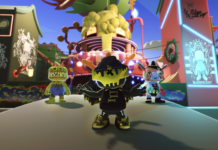Before I tell you all about my time with Child of Light, I'm going to tell you a story. Bear with me, and enjoy this rather frustrating tale. I was all set earlier this week to head out from Los Angeles to San Francisco to check out Ubisoft's upcoming JRPG. I got to the airport on time and checked in, eagerly anticipating my 1:30 PM appointment with the Rayman and Assassin's Creed developer. Then my flight was delayed … until 1:30, my appointment time. I got to San Francisco at 3:10, took a taxi to the preview session, and got there at 3:30.
I spent roughly an hour both playing Child of Light and interviewing Lead Writer Jeffrey Yohalem, who most recently worked on Far Cry 3. I then headed back to the airport to catch my 5:50 flight, which I ended up missing. So my ticket was exchanged for a 6:30 flight … which was also delayed. To top it off, due to turbulence, the flight attendants canceled all services right before they got to me, leaving my water-deprived, pathetic self a parched, sleepy, dizzy mess.
Yet it was all totally worth it because my time with Child of Light was absolutely mesmerizing.

You see, the brief moments I spent immersed in the game's painting-like storybook world, I was completely and utterly hypnotized. I was enthralled by its artistry and its poetry, and I was captivated by its desire to tell a story in a different way. Child of Light has been described as a “playable poem,” and there's a reason for that. The way the story unfolds — the interactions, the dialogue, the characters, the visuals — makes for an experience that's poetic due to both its text and its visuals.
You play as Aurora, a young girl who falls ill and awakens in what she believes is a dream world. Desperate to find her father, she sets out for adventure. The writing in Child of Light is delivered in rhymes. Narration, conversations, and information are often fed to you in a manner that sounds undeniably poetic. For folks who aren't into deciphering riddles, fret not, because the storyline is in no way esoteric or confusing.
Aside from being one big poem, Child of Light is also a modern storybook fantasy. The game has an elegantly alluring hand-painted look to it. I was impressed to see the UbiArt engine utilized in a manner that's vastly different from the Rayman games. Those games looked quite splendid, no doubt, but Child of Light looks and feels like something you'd find within the confines of a hardcover fantasy. Backgrounds and foregrounds are detailed with graceful brushstrokes and fine line usage, and the color is absolutely alluring.

Child of Light isn't just a lovely poem to read or an attractive work to behold — judging from the time I spent with it, there's a solid game to play there, too. While it's been described as a cross between platformer and JRPG, I found that the latter takes over. That's not a bad thing, because the platforming gameplay goes in a much more exploratory direction. Yes, you do run from left to right (and often from right to left), push blocks, and jump over pits, but those are simply means for exploration of the game's world.
If you're expecting something like the Rayman games, it's important to note that this isn't that kind of experience. You won't be challenged to perform countless tricky jumps or run at high speeds to get through a clever obstacle. Instead, the platforming in Child of Light lets you unravel more of the world, more of the story, and more secrets.
The JRPG gameplay, on the other hand, is a much more ostensible mechanic. As you adventure through fantastical lands, you'll encounter all kinds of enemies. Haunting spirits, stone creatures, and monstrous insects are just a few of the enemy types, but there are plenty of baddies that look like they were taken right out of a dark fairytale. While enemies can be avoided a lot of the time, battling them will help you level up and boost your stats. Like many JRPGs, it's usually best to just take them on and reap the benefits of combat.

Battles don't exactly play out in turn-based fashion. Instead, Child of Light utilizes a style of combat that's reminiscent of the Active-Time Battle System found in Final Fantasy games. A meter at the bottom of the screen indicates when you can make a move, be it offensive or defensive. If you choose to defend, even if your enemy gets the first strike, your block will be factored in first, allowing you to receive less damage. If you choose to attack but the enemy still gets that first hit, your move will be interrupted. In addition, you can use your sprite companion Igniculus to blind enemies, noticeably stalling their next move.
Combat is quite intuitive to grasp once you're actually playing. Aside from your sword strikes (Aurora has a pretty rad sword-in-the-stone moment at the start of the game), you also have magic attacks. You can infuse your blade with fire, utilize light magic, and so on. Like in most JRPGs, some attacks aren't as effective depending on the enemy type. Dark enemies, for example, will get crushed by your light magic, but light enemies will barely take a small dose of damage. Winning battles grants you XP, which can be used to assign new abilities and improve stats.
I had to deal with several stressful hours at airports, in planes, and in cars just to play Child of Light for a few minutes, but it was all worth the trouble. Throughout the time I spent playing, I was captured by the game's poetic storytelling, delightful art style, enjoyable platforming, and entertaining battles. I'm excited to play more Child of Light come the game's April 30 launch, and I can't wait to jump back into its spellbinding fantasy land. If you're a fan of old school JRPGs and storybook fantasies, you should totally be excited, too.
Want to talk about indie games, Kirby, or cheap pizza? Follow me on Twitter @dr_davidsanchez.










